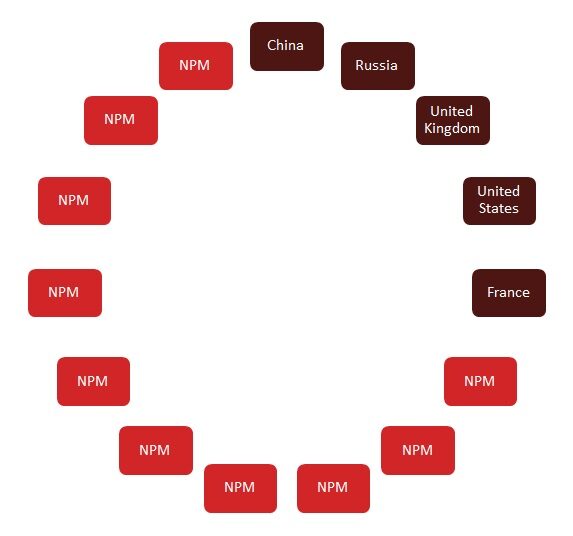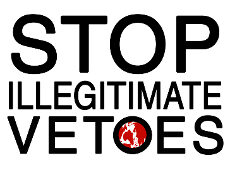What is the veto, and how did it become to be?
- • The United Nations Security Council can take decisions that are legally binding for members of the UN. They can even authorize the use of force to maintain international peace and security. Such a decision is called a resolution.
- The United Nations Charter requires affirmative votes of all five permanent members to pass a Security Council resolution, thereby giving a de facto veto power to them. They cannot vote against a resolution without vetoing it.
- Instead, a permanent member can choose to abstain from voting to show dislike for a draft resolution, without actually vetoing it.
- At the time of the formation of the UN, the major powers were hesitant to join, due to a fear of a hostile majority in the Council. Since the international community considered that without them the UN was doomed to fail in its mission, a compromise was accepted in the form of a veto power for the permanent five members.
The permanent FIVE members of the UNSC

The United Nations Security Council plays an extraordinary role in international relations. It is the only body of the United Nations that can authorize the use of force. It is tasked to do so when it is necessary to maintain international peace and security. To do this, a resolution must pass in a session with the Security Council’s fifteen members. Five of those members play a particular role in the Council. They are the Permanent Five – or P5 for short. Unlike the rest of the Council, their membership does not change hands every two years and they have been part of the Council since its inception.
There are fifteen members of the United Nations Security Council. Five of them are permanent members – The P5 – and the others are non-permanent members (here denoted by “NPM”) whose membership is limited to two years at a time. After that time, the membership of the Council is reelected.
Apart from having their seat on the Council guaranteed by the UN Charter, the P5 also play a vital role in the decision-making. This is because they have the right to block important decisions with what is called the Security Council veto. The Charter, in Article 27, states that:
The Charter, in Article 27, states that:
“1. Each member of the Security Council shall have one vote.
2. Decisions of the Security Council on procedural matters shall be made by an affirmative vote of nine members.
3. Decisions of the Security Council on all other matters shall be made by an affirmative vote of nine members including the concurring votes of the permanent members; provided that, in decisions under Chapter VI, and under paragraph 3 of Article 52, a party to a dispute shall abstain from voting.”
This means that in any non-procedural matter, a decision is made if two criteria are met. First, nine of the Council’s fifteen members must vote in favor of the resolution. Second, none of the P5 must vote “no”. A P5 member can show
its disapproval either by abstaining from a vote or by voting no, effectively making a decision impossible. In other words, a P5 member cannot vote no and still allow the decision to pass. For the P5 a no vote and a veto are one
and the same.
To avoid blocking something acceptable, but less-than-optimal, the P5 have repeatedly resorted to abstentions. One of the permanent members may, for instance, be unwilling to support a resolution because it does not agree with all
of its provisions, but it may still not want to veto it, because the consequences of blocking the resolution may not seem worth it, either due to negative consequences related to the situation, or because the veto casting state can
often expect a lot of criticism for their decision to veto. Abstentions are therefore a very common way of expressing displeasure with a resolution for both the P5 and the NPM. For example, Russia, which has frequently vetoed draft
resolutions relating to the conflict in Syria, has also often abstained from voting to allow at least some resolutions to pass.
Read More:
Where did the veto come from?
The United Nations was not the first attempt at an international organization with the mission to promote international peace and security. In the period between the World Wars, there was the League of Nations. The League of Nations was plagued by problems arising from both a distrustful climate in international relations and from how the organization was set up to work. Among its problems was a consensus-based voting procedure, in the forerunner to both the Security Council and the General Assembly. This meant in practice that all members of the League had a veto. The League of Nations collapsed with the onset of World War II. As the second half of the 1940’s approached, however, there was an initiative to once again try to cooperate internationally to avoid war. The end of the war meant that there was an opportunity to do just that. Having learnt from the experience of the League, the founders of the UN restricted the veto considerably.
Despite these changes the veto power remains.
The Security Council in session
The most powerful states at the time of the founding of the UN (today’s P5) were key to making the new organization work. The United States had not been member of the League of Nations, despite President Woodrow Wilson being one of
the main initiators of the institution. This meant that the League of Nations never reached the acceptance it needed to take forceful action. If this was to be avoided, the founders of the UN had to make sure that all the major powers
were on board. Those states, however, were distrustful of each other and did not want to put important decisions of security into the hands of a possibly hostile majority in the Council.
For that reason the veto remained, but only for the five permanent member states. Restricting the veto is part of reasons why the United Nations is much more successful than the League of Nations. However, having five members still
retaining the veto power is also one of the biggest failures of the UN. The veto is not only used to protect the P5s utmost security or sovereignty interests, rather, it far more frequently often used to protect the states’ economic
interests, or for cheap political reasons, and to protect allies from accountability. This frequent misuse of the veto undermines the legitimacy of the Council, and it drastically prevents it from effectively fulfilling its duty
– to maintain international peace and security.
See our report, Legitimate Concerns, for more information about how the veto is used by the permanent members.
Contact us: [email protected] or see our social media for up-to-date discussions
and the campaign news feed.

